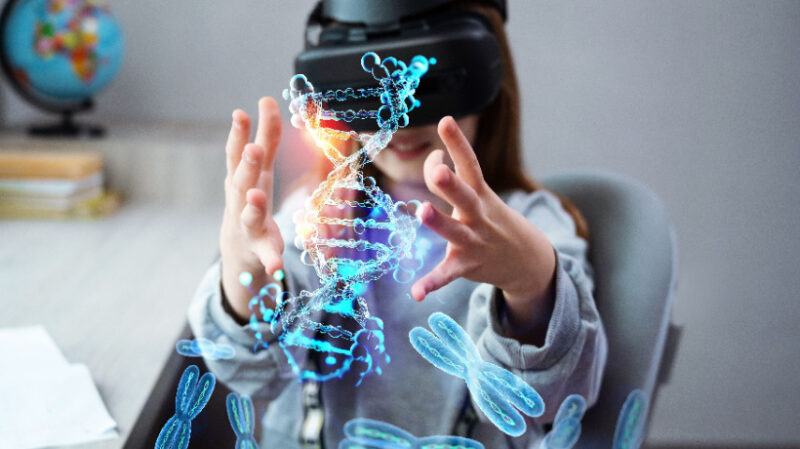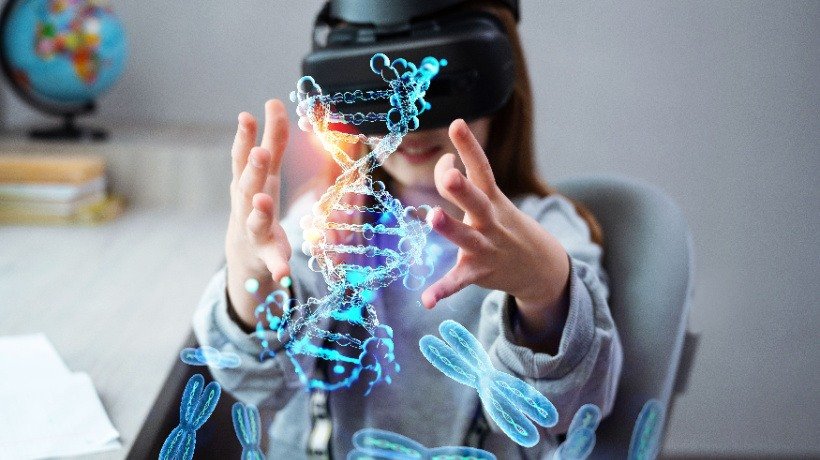
Exploring The Impact Of VR Technologies In Education
Education is rapidly changing, and technology is leading this shift. One of the most exciting advancements is the use of Virtual Reality (VR) in classrooms. Imagine stepping into a history lesson and suddenly finding yourself in ancient Rome, or attending a biology class where you can explore the human body from the inside. With VR, these once far-fetched scenarios are becoming a reality. Investments in education technology are expected to surpass $400 billion by 2025, with VR playing a significant role in that growth. It’s not just a fancy gadget; it’s changing how students learn and interact with information, making education more engaging, immersive, and effective.
VR In Education: What Is It All About?
VR in eLearning is about creating lifelike experiences that make learning more tangible. Instead of reading about the Amazon rainforest, students can virtually walk through it. With a VR headset, they can see, hear, and even “feel” the environment around them. This level of immersion helps students understand concepts better than they would through traditional methods.
The best part? VR allows for real-time feedback. Teachers can see how students are progressing and make adjustments to ensure everyone is keeping up. This personalized approach caters to different learning styles and speeds, making education more accessible.
Why VR Is A Game-Changer For Learning
VR brings several benefits to the table, making it a powerful tool for modern education:
1. Learning Becomes An Adventure
Traditional learning methods can sometimes feel dry. VR makes things more exciting by turning learning into an interactive adventure. Imagine exploring the pyramids of Egypt or navigating through the solar system, all from your classroom. When learning feels like an adventure, students are more likely to stay engaged and remember what they’ve learned.
2. Practice Without The Pressure
One of the most valuable aspects of VR is the ability to practice in a safe environment. Whether it’s a medical student performing a delicate procedure or an engineering student testing a new design, VR allows for mistakes without real-world consequences. This kind of hands-on experience builds confidence and skills in a way that’s both safe and effective.
3. Bringing People Together
VR breaks down geographical barriers, allowing students from all over the world to collaborate and learn together. Whether a group project or a virtual classroom discussion, VR fosters connections and teamwork in ways that traditional methods can’t. It’s like having the whole world as your classroom.
4. Keeping Students Engaged
Keeping students motivated is one of education’s biggest challenges. VR addresses this by making learning fun and interactive. When students can actively participate in their learning—rather than just passively listening—they’re more likely to stay focused and excited about what they’re studying.
5. A Cost-Effective Solution
While the initial investment in VR technology might seem steep, it can actually save schools money in the long run. Instead of expensive lab equipment or field trips, VR provides a cost-effective alternative. Plus, it’s scalable, meaning it can accommodate many students at once, making it a smart investment for schools looking to expand their offerings.
Bridging Education And Entertainment With VR: A New Frontier
Virtual Reality isn’t just transforming classrooms; it’s also making waves in the world of gaming. The same technology that lets students dive into ancient history or explore the human body is being used to create some of the best metaverse games available today. These games aren’t just about fun—they offer expansive virtual worlds where players can learn, interact, and grow in ways that echo educational VR experiences.
Imagine a history lesson where you can walk through ancient Rome, and then jump into a metaverse game that lets you explore a similar Roman city more interactively and playfully. These metaverse games provide an immersive experience that blends learning with entertainment, showing how VR is blurring the lines between education and play.
Challenges And Future Of VR In Education
Like any emerging technology, VR in education comes with its own set of challenges. The cost of VR equipment, the need for technical support, and concerns about screen time are some of the obstacles schools face. However, as the technology evolves and becomes more affordable, these issues are likely to decrease.
Looking ahead, the future of VR in education appears promising. As more research and development go into improving VR experiences, it’s set to become a staple in classrooms worldwide. The potential to transform education is immense, and we’re only scratching the surface.
Final Thoughts
Virtual Reality is not just a trend—it’s a powerful tool changing the landscape of education. By making learning more engaging, interactive, and inclusive, VR is helping students connect with their studies in ways that traditional methods can’t match. As this technology continues to evolve, it’s set to play a significant role in shaping the future of education, one virtual step at a time.






amoxil price – order amoxil without prescription amoxicillin online
generic amoxicillin – https://combamoxi.com/ amoxil sale
buy fluconazole online – https://gpdifluca.com/ fluconazole medication
buy diflucan online – https://gpdifluca.com/# diflucan 100mg for sale
cenforce over the counter – cenforce 100mg brand cenforce cheap
purchase cenforce for sale – https://cenforcers.com/ order cenforce 100mg pills
cialis price walgreens – https://ciltadgn.com/# side effects of cialis daily
how well does cialis work – who makes cialis cialis where can i buy
tadalafil tablets erectafil 20 – click buy cialis without prescription
how to get cialis prescription online – cialis black review how many mg of cialis should i take
order zantac pill – https://aranitidine.com/ ranitidine 150mg uk